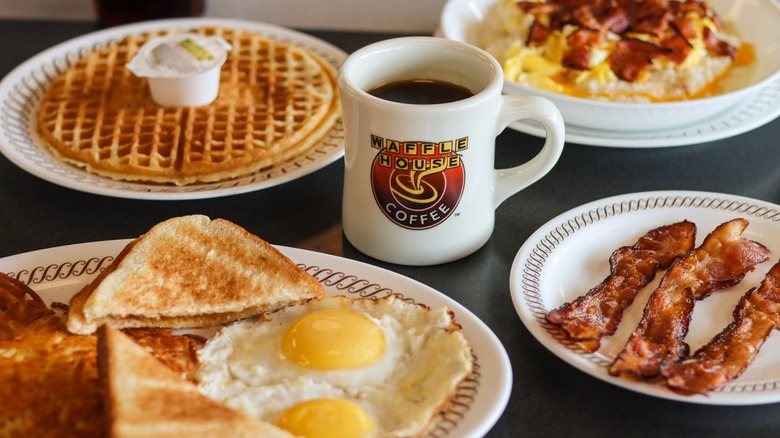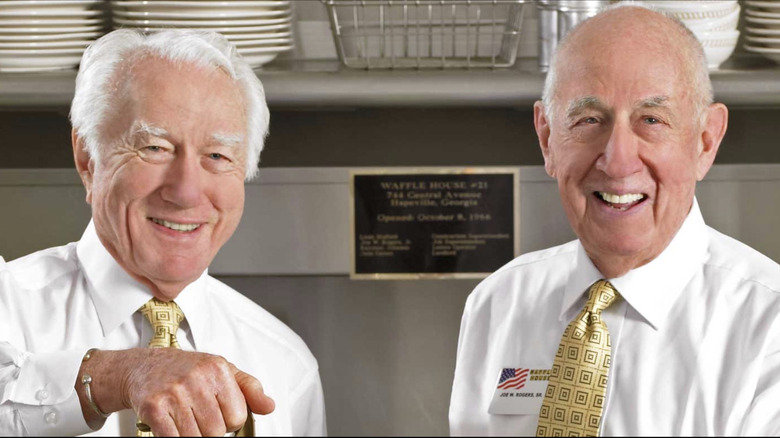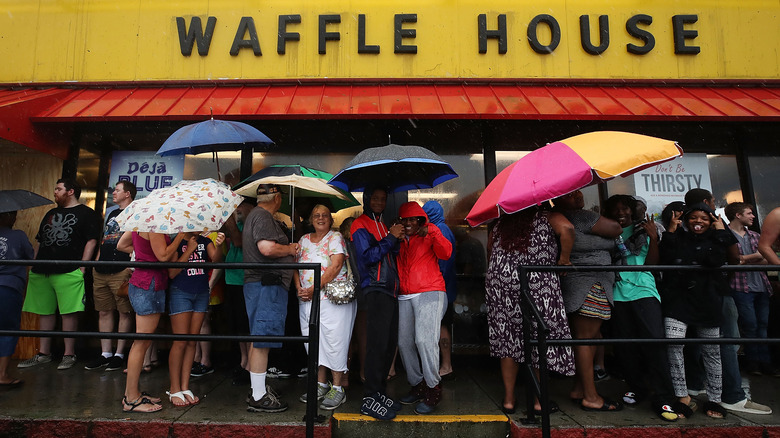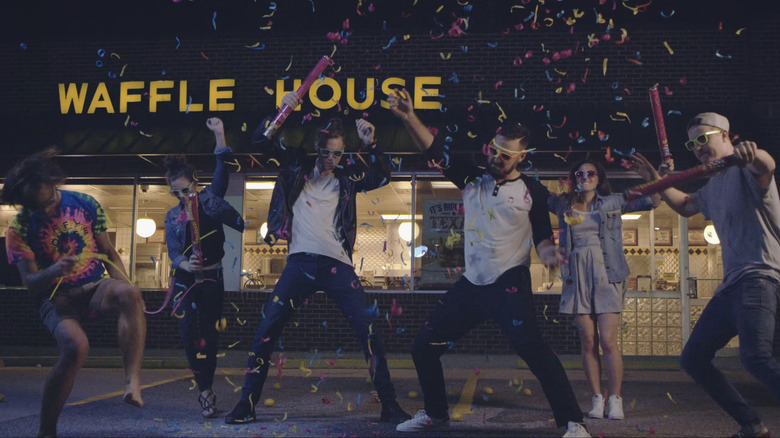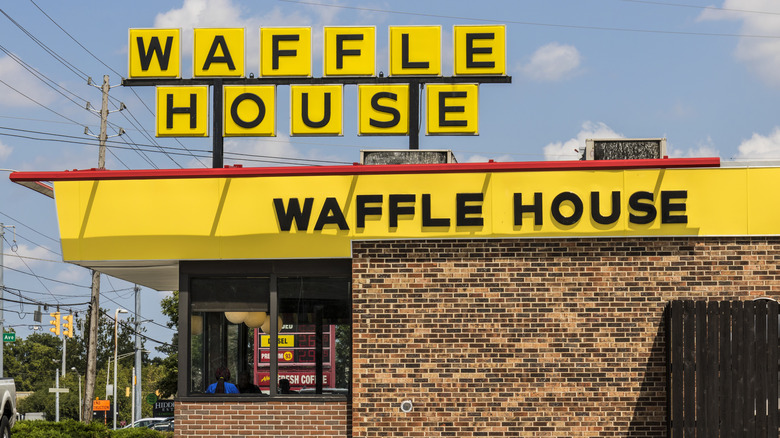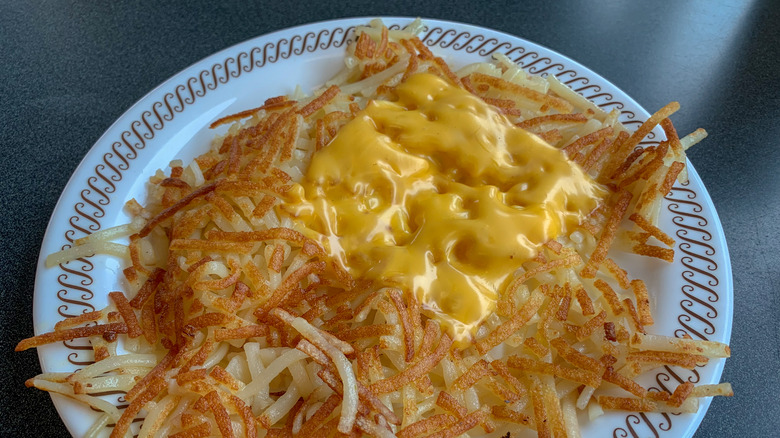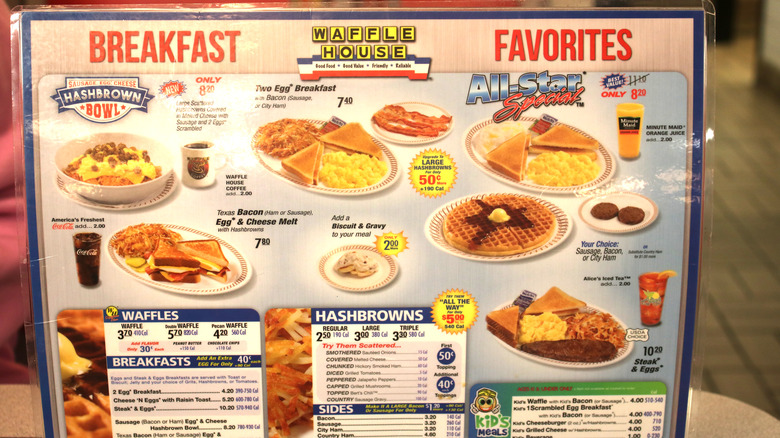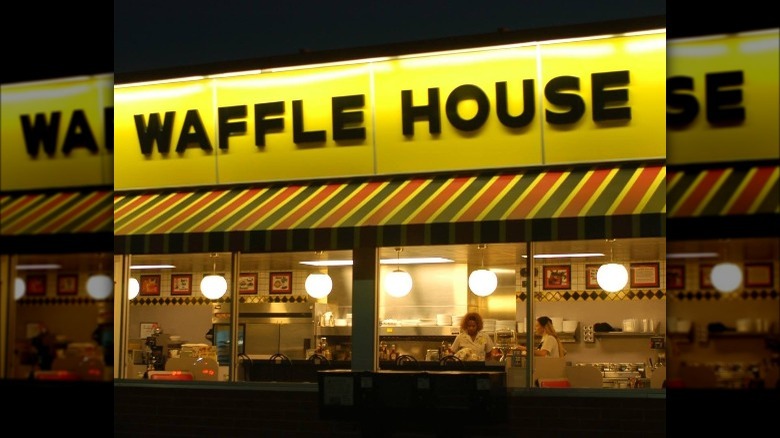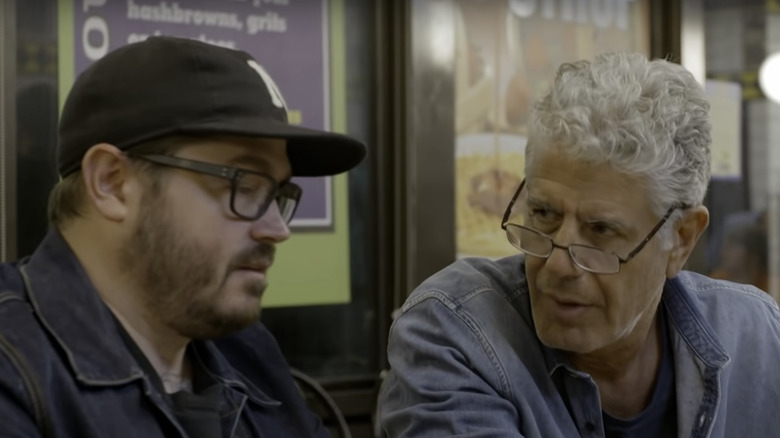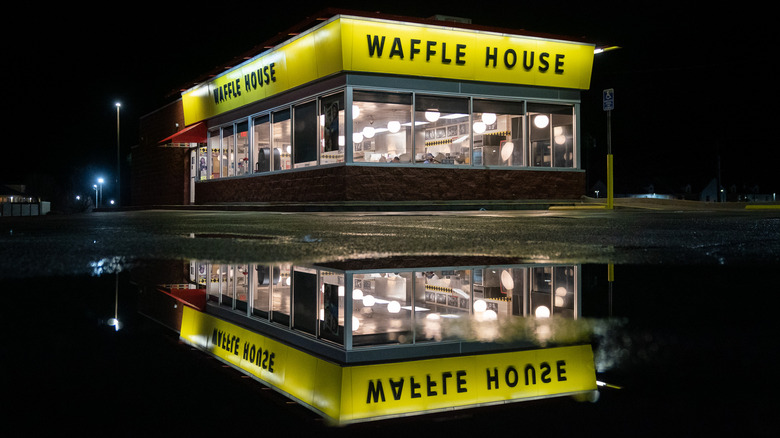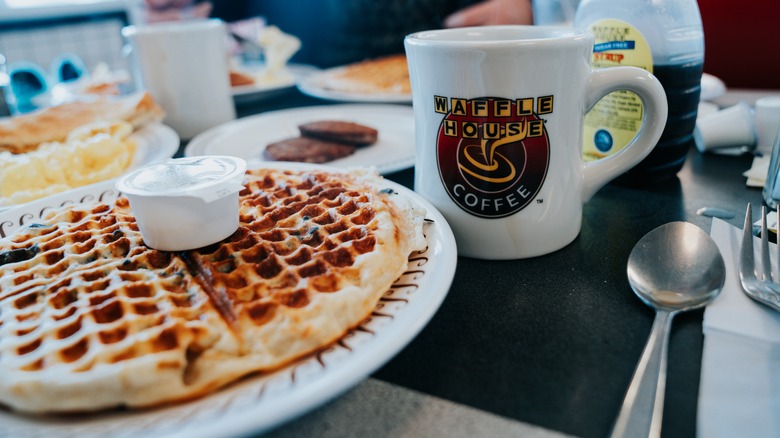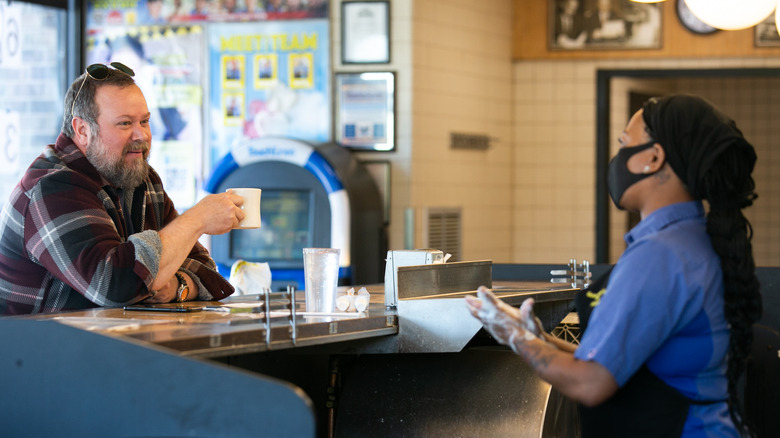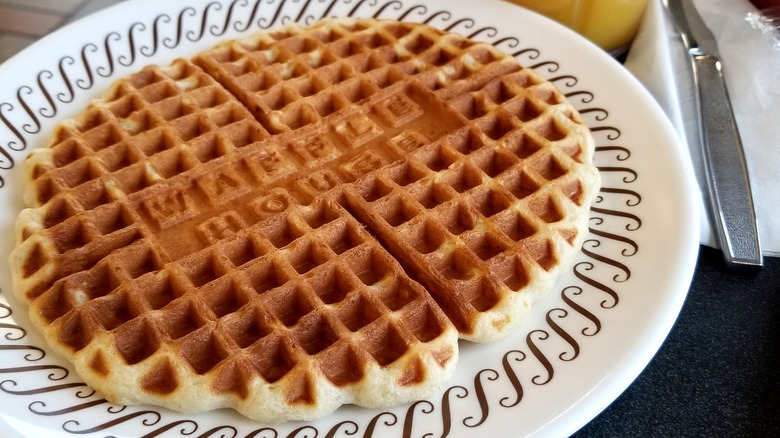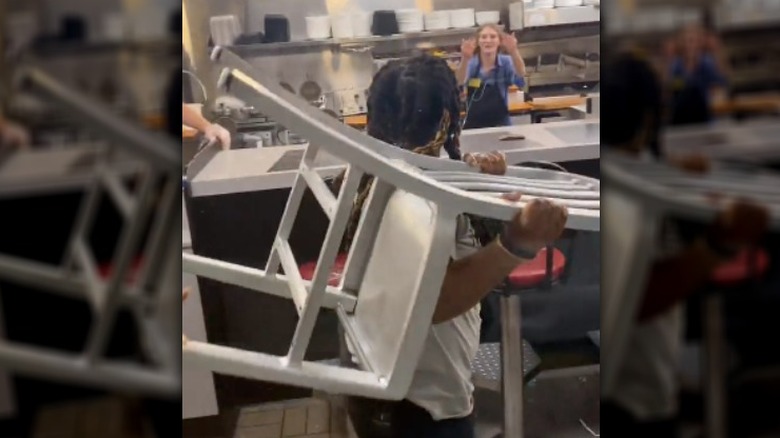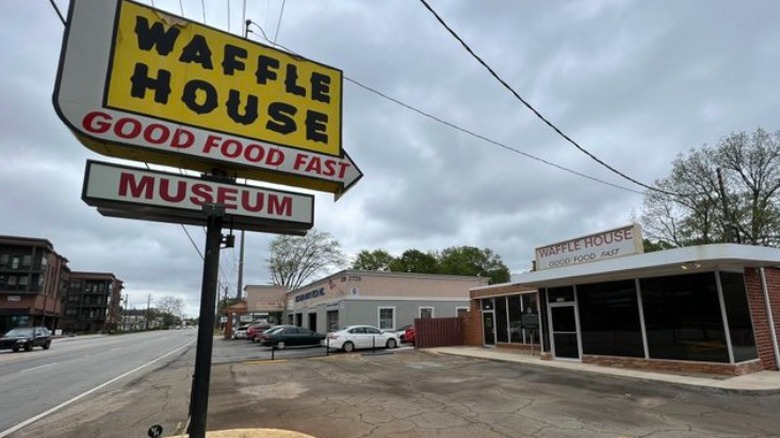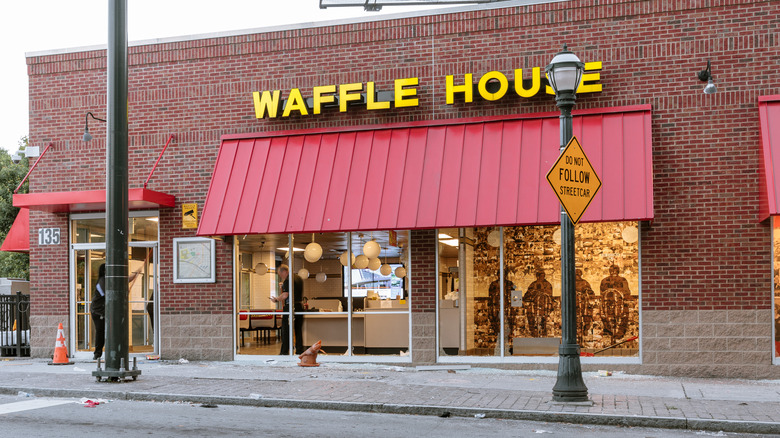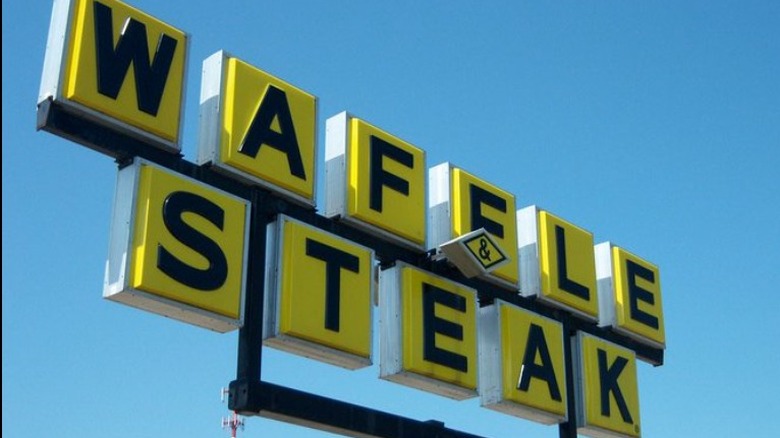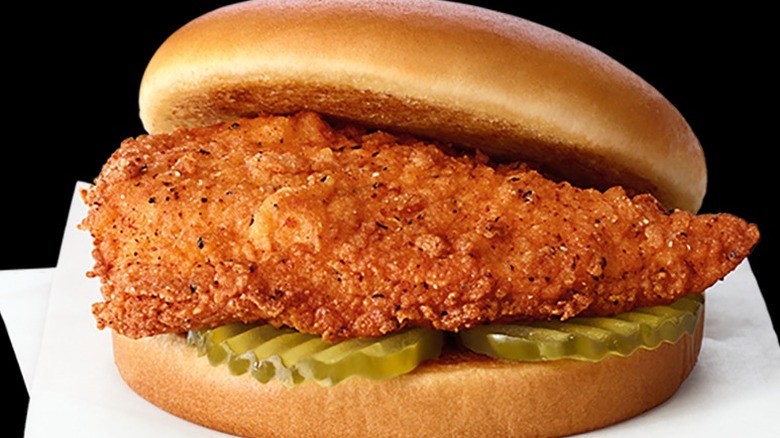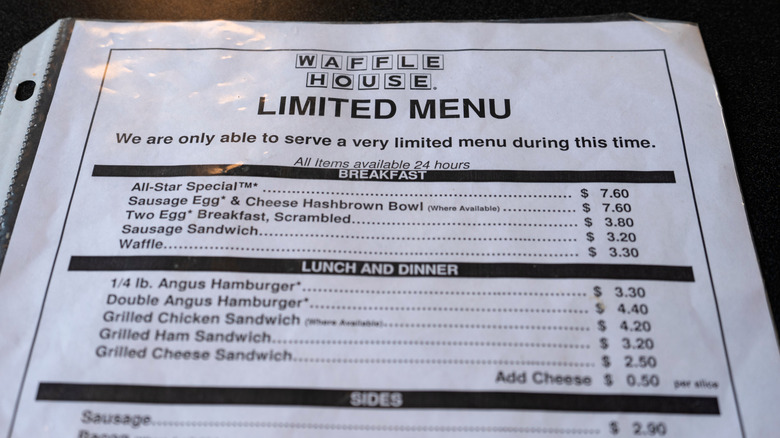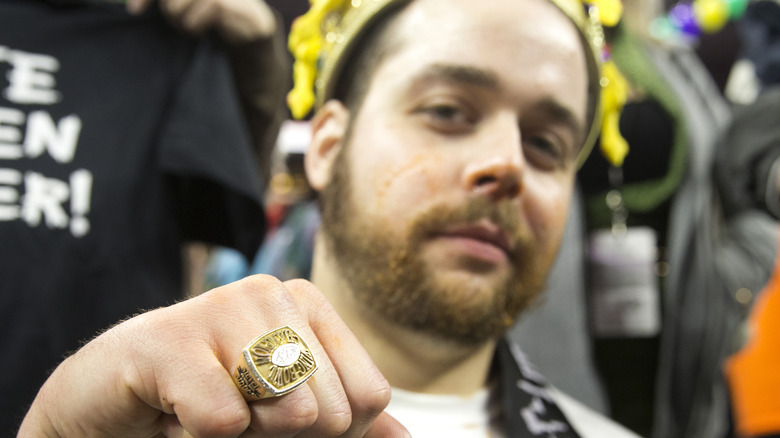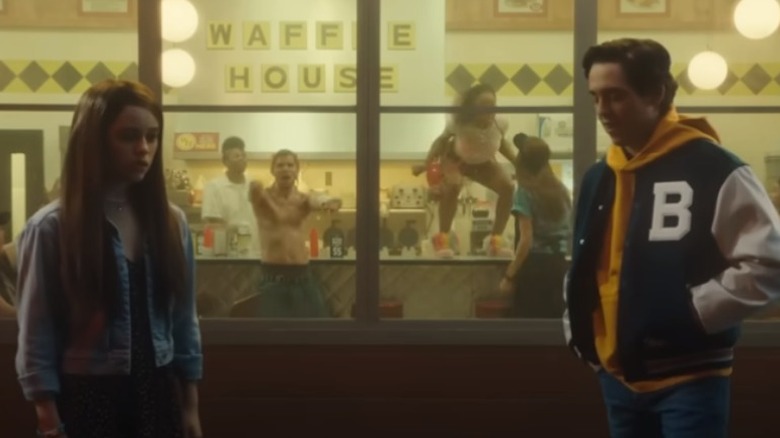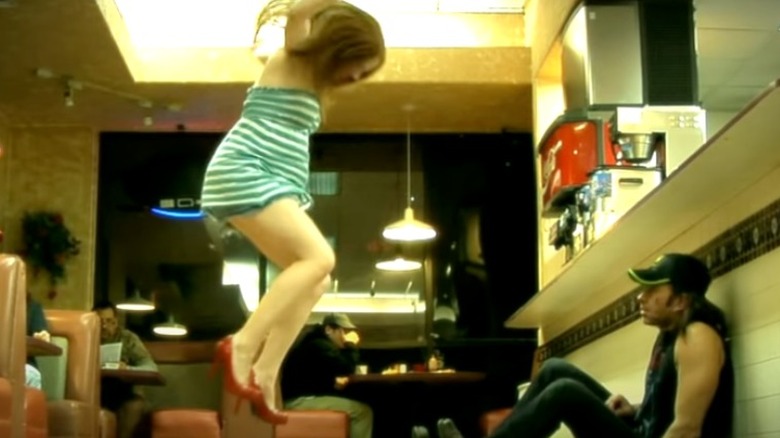Waffle House: What You Should Know About The Iconic Diner
Picture this: It's 4 a.m. and maybe you've had a few cocktails or been out with your friends all night. You had dinner, but that was hours ago, and now you need another meal in your belly before you head home to pass out. What do you do to feed your empty tummy? For most of us, that answer involves copious amounts of grease, carbs, and cheese. If you live somewhere in the southern half of the U.S., there's a very good chance your go-to spot in this situation is Waffle House.
Waffle House has built its reputation on its excellent renditions of American diner classics, especially breakfast foods like its eponymous waffles (via Atlanta Eats). There are other breakfast chains out there, like IHOP and Denny's, but none inspire the devotion from fans that Waffle House does — sorry Northerners and West Coasters, you're just going to have to take a road trip to the South if you want to eat at one of the best chain diners in America. Waffle House devotees have created their own culture with its own special language and customs, and Waffle House regulars are very attached to their favorite menu items.
Just because Waffle House is universally beloved doesn't mean it has a completely unblemished track record, though. We dug into Waffle House's lore to uncover the scattered, smothered, and covered story behind this American icon.
The company started as a single diner in suburban Atlanta
Waffle House has close to 2,000 restaurants these days, but most empires start small. Waffle House is no different. It began in 1955 as a 24-hour diner in Avondale Estates, a suburban community located outside of Atlanta, Georgia. The restaurant was founded by two neighbors, Joe Rogers Sr. and Tom Forkner. Per The Atlanta Journal-Constitution, Rogers was a World War II vet who started cooking at a diner chain called the Toddle House in 1947. He rose up through that company's organization and became an executive before opening Waffle House with Forkner, who previously worked in real estate.
From the beginning, the founders' concept for Waffle House was to make comforting, simple food and serve it in a way that made patrons feel welcome. The original menu had only 16 items on it, and the restaurant was named after the most popular order: waffles (via ESPN). According to the Georgia Historical Society, Rogers' and Forkner's initial dream involved opening just one location, but that didn't stop them from expanding relatively quickly once the original Waffle House became an overnight success. The second location opened only two years after the first, and by the 1960s, new locations started opening at a more rapid pace.
FEMA has a Waffle House Index for measuring disasters
Waffle House restaurants are all open 24 hours a day, 7 days a week. That commitment to staying open all the time even applies in areas that are suffering from natural disasters. Waffle House uses portable generators to keep restaurants running through power outages and studies its responses to previous disasters to learn how it can do better in the future (via Disaster Philanthropy). Staying open as much as possible helps give Waffle House customers a place of refuge in difficult times. It also allows the company's employees to continue earning money instead of losing wages to restaurant closures.
So if the Waffle House locations somewhere are planning to close, you can almost guarantee that the area will experience some scary weather. In fact, according to USA Today, Waffle House's emergency preparedness is so widely renowned that it spawned an unofficial way of measuring the severity of a natural disaster: the Waffle House Index. The Index was created by Craig Fugate, who was the FEMA administrator in 2011. The Waffle House Index is a three-color system. Green means all the Waffle Houses are operating fully and that you probably don't have to worry. Yellow means that Waffle House may have to run a limited menu or run off of generator power. Red means you should get out of town because all the Waffle Houses are closing down.
Waffle House has its own record label
When you think of what Waffle House sells, the mind naturally goes to classic comfort foods like grits, hash browns, and (of course) waffles. It might surprise you that the company has a side business that creates a very different product: recorded music.
It turns out that Waffle House has a record label, and the chain has been making music for quite some time. Per NPR, the record label was the brainchild of Joe Rogers Sr. and has been in operation since the mid-1980s. While all the songs reference Waffle House or food in some way, they're not exactly jingles. Instead, they're songs in a variety of popular genres that you wouldn't necessarily notice were Waffle House-specific unless you listened closely to the lyrics.
In the '80s, Waffle House's songs were pressed on real 45 rpm records and inserted into the jukeboxes in Waffle House restaurants. These days, they're still playing on Waffle House jukeboxes, but everything has gone digital. Unsurprisingly, the custom Waffle House songs aren't as popular as the other songs on the jukeboxes, but they do get played every once in a while. The chain has also made some music videos for some of its songs that you can view on the Waffle House website.
Some locations have been accused of racism
Waffle House has generated a lot of bad press related to alleged racism and gender discrimination. According to Funding Universe, in the period between 1995 and 2000, the company racked up over 90 lawsuits related to claims of sexual harassment and racism. In 2018, Bernice King, who is Martin Luther King Jr.'s daughter, called for customers to boycott Waffle House after a string of incidents, including two instances of police violence against Black customers at Waffle House locations (via Inc.). Quartz has a list of racist allegations about Waffle House stretching back to 1984. The details of each case vary, but repeating patterns include Black workers alleging unequal treatment and Black customers being denied service, being made to feel unsafe, or not receiving the same level of service as white patrons. More recently, non-white customers at Waffle House locations in Florida and Georgia were allegedly subjected to racial slurs and threats.
Waffle House co-founder Joe Rogers Sr. didn't view his business as racist. He told The Atlanta Journal-Constitution in 2004 that Waffle House served Black civil rights protestors in the '60s during a time when many Atlanta-area businesses denied them service. It should be noted that the racist incidents discussed above all occurred at specific Waffle House locations and may not reflect the values of the company as a whole. However, the frequency and sheer number of the allegations is rather troubling.
There is a complex code for ordering hash browns
As a large and popular institution, Waffle House has created its own special culture. Nowhere is that more apparent than in the terminology used for ordering hash browns, which can be quite confusing to a Waffle House newcomer. You might not think of hash browns as being a complicated dish — aren't they just crispy shredded potatoes? You can order plain hash browns from Waffle House if you want, but the restaurant's fans love adding a wide variety of toppings to trick out their shredded spuds.
Each topping has its own special Waffle House-specific name. Plain hash browns are "scattered" because the potatoes are simply spread over the grill. Ordering "smothered" hash browns adds griddled onions. A slice of American Cheese makes them "covered." We could go on, but you can just read the whole list for yourself from The Atlanta Journal-Constitution. Our favorite customization is "country," which means the hash browns get coated in creamy sausage gravy. Waffle House reportedly says there are over 1.5 million possible hash brown variations you can order.
As reported by Garden & Gun, although the customized hash browns are now synonymous with Waffle House, they didn't become common until the 1980s. They were born in Atlanta-area Waffle Houses where line cooks would whip up their own magical hash brown creations as treats for themselves.
The workers communicate using condiments
The unique hash brown lingo isn't the only Waffle House communication innovation. The servers also give customer orders to the cooks in a surprising manner. Rather than simply calling out the orders verbally or relying on printed tickets to communicate what needs to be cooked, employees at Waffle House are trained to use something called the mark system (via ESPN).
The mark system uses objects like condiment packets, pickles, slices of bread, and utensils to tell the grill cooks what they need to cook next, with no talking or reading necessary. For example, a mustard packet face-up on a plate signals a pork chop, a butter packet means a waffle, and a packet of grape jelly means white toast. However, it gets even more complicated than that because the position and orientation of the objects also change their meaning. A grape jelly by itself means toast, but if it's on the right side of an oval plate, it means a sausage omelet. A mayo packet on top of a packet of jelly means eggs scrambled well, while an upside-down mayo packet on top of butter means a dark waffle. The fact that Waffle House griddle cooks are able to cook up food so quickly and accurately using this arcane system makes us even more impressed with them than we were before.
Waffle House loves cash
Waffle House has long resisted the move toward a cashless society. As Joe Rogers Sr. put it to The Atlanta Journal-Constitution in 2004, Waffle House's mission has always been "taking care of the poor old cash customer." The company didn't start accepting card payments until 2006, according to QSR Magazine.
Waffle House's commitment to cash doesn't stop with its customers, either. Reviews from Waffle House workers on job sites indicate that employees can also get paid in cash rather than check or direct deposit if they choose to. One Waffle House waitress on Glassdoor said, "you get paid weekly in cash." Another reviewer on the same site mentioned that they received their Christmas bonus in cash as well. It's the same story over at Indeed, where one former employee wrote, "We get paid in cash weekly by our managers at the store." Another employee said that workers who opted for direct deposit got paid on a different day than employees who accepted their pay in cash. We should note that the most recent of these reviews is from 2017, so there is a possibility that the company no longer offers cash compensation to employees.
It has many celebrity fans
The food at Waffle House may be simple, but it's tasty, and it makes you feel good, so it shouldn't be a surprise that celebrities love the restaurant just as much as regular folks do. One of the most famous people to sing Waffle House's praises was Anthony Bourdain, who was introduced to the chain by chef Sean Brock. Bourdain loved Waffle House and waxed poetic about it during his visit, describing it in the way only he could: "Its warm, yellow glow, a beacon of hope and salvation, inviting the hungry, the lost, the seriously hammered all across the South to come inside, a place of safety and nourishment" (via ESPN).
In addition to food celebrities, famous rappers have also frequently shouted out their love for Waffle House. A 2013 feature from First We Feast collects lyrical references to the chain in music from artists like Gucci Mane, 2Chainz, Future, and Jay Z. In 2019, The Atlanta Journal-Constitution asked a bunch of local rappers to name their favorite Waffle House orders, and they did not disappoint. Ludacris proclaimed his love for the patty melt, as did Lil Baby. All three members of Migos had their own favorites, with Quavo repping the All-Star Meal, Offset favoring the Texas Melt, and Takeoff opting for waffles with a pork chop on the side. Perhaps the strangest answer came from Lil Yachty, who said he liked to make a bacon, butter, and jelly sandwich on Texas toast.
Sometimes things can get a little rowdy
Videos of Waffle House fights are a known entity on the internet, so much so that you can even find Waffle House fight compilations on YouTube (warning: all the fight videos we link to include profanity and violence). We would like to point out that we don't think Waffle House is cultivating an unsafe environment. It just happens to operate thousands of restaurants that are open 24 hours a day, and in the wee small hours of the morning, you're bound to occasionally encounter people who are a little bit too inebriated and spoiling for a fight.
One thing you'll notice in several Waffle House fight videos is that when customers get violent, Waffle House employees can showcase some impressive fighting skills. The fighting prowess of Waffle House employees has been the subject of many jokes on Twitter. One user wrote, "Waffle House requires every employee to know how to fight specifically for moments like this." Another user jokingly claimed, "When you apply to Waffle House the only thing they ask is 'can you fight.'" And one basically summed up the internet's opinion when they stated, "Waffle House employees are the undefeated heavyweight champions of the world." Of course, nobody wants to experience violence at their place of work, and some of these fights look pretty scary, but it's hard not to root for the underdog Waffle House employees when they have to deal with unpleasant and violent people.
Waffle House doesn't do traditional advertising
Waffle House's incredible amount of success over the years is even more impressive when you learn that the company has almost entirely eschewed traditional forms of advertising. According to the Georgia Historical Society, Waffle House has never made many TV or radio commercials or print ads. Instead, as Funding Universe writes, people tend to learn about the chain from other people who love it.
In addition to the word-of-mouth marketing strategy, Waffle House also reels in customers by placing its restaurants (with their large, iconic, yellow signs), close to busy highways. Per Funding Universe, Waffle House expanded in tandem with the U.S. interstate highway system in the mid-20th century. With interstate highways bringing in steady streams of customers, the company was able to gradually open more and more restaurants across the American South. As America's roadside food options settled into a now-familiar landscape of fast food drive-thrus, Waffle House set itself apart by offering old-school diner service that has remained basically unchanged since its founding in 1955.
The workers get some nice perks
Working at Waffle House is a tough job in many respects. You often have to work nights, weekends, and holidays, the restaurant is frequently very busy, and the customers can sometimes get a little out of hand. It's certainly not a job for everyone, but the gig has some good perks, too.
Waffle House works hard to try to retain employees. It has been offering health insurance since the 1980s, which is something of a rarity in the restaurant industry (via FSR Magazine). It also promotes people, at every level of the business, exclusively from within, rather than hiring outsiders. The company offers stock options to employees, and cooks earn bonuses based on how much food they prepare each day. Perhaps most enticingly, managers are guaranteed a six days on, two days off work schedule. In an industry with notoriously unpredictable scheduling practices, this kind of stability is quite enticing. Both managers and hourly workers also get paid time off, another uncommon benefit in the service industry.
Waffle House's name is all about profits
We'd not blame you if you thought that Waffle House is called "Waffle House" because of its great waffles. If you've somehow managed to never order waffles from the restaurant, you're missing a real treat because they do have better-than-average waffles. However, the real reason the restaurant has "waffle" in its name is all about making money.
The truth is that the founders, Joe Rogers Sr. and Tom Forkner, focused in on their biggest money-maker when naming their restaurant. The main ingredients for waffles -– flour, eggs, and sugar -– don't cost nearly as much as the fixings needed to make any of the other original 16 menu items, which means they can mark up the price a little more to make more money. By putting the name of their biggest profit-maker in the restaurant's name, the founders ensured everyone would think the chain was known for its waffles and be sure to order some.
Waffle House Wendy made headlines
As we said earlier, it's not unusual to expect a little late-night disorderliness at Waffle House. When everything else is closed for the night and Waffle House is the only place to hang out, crazy things can happen. However, in September 2021, utter mayhem broke out at an Austin, Texas, Waffle House. A fight that started among apparently drunk, impatient customers in a corner of the restaurant escalated when an employee threw a sugar shaker over the counter into the fray. Two of the brawling ladies immediately jumped over the counter to confront the employee, who the internet started referring to as "Waffle House Wendy." "Waffle House Wendy" immediately launched into movie-hero mode and started throwing some serious punches to defend herself, effortlessly deflecting a flying chair as if it was something she did every day.
It turns out that "Waffle House Wendy's" real name is Halie Booth. She told Fox News that she had no fighting background and that her response was fueled solely by adrenaline. While her superiors at Waffle House thanked her for protecting the store after viewing videos from that night, they still wrote her up for destroying the sugar shaker she threw over the counter. Unfortunately, when Booth later tried to get a job at a Waffle House in another state, she said she discovered that the chain wouldn't consider hiring her as a Waffle House defender again.
The original Waffle House became a museum
If you ever find yourself driving through Avondale Estates, Georgia, you can visit the very first Waffle House. While the building was transformed into a Chinese restaurant in the 1970s, the company later remodeled it to look like the original Waffle House before turning it into a museum. If you're interested in visiting, you'll need to contact the museum for a private tour instead of just dropping in unannounced. With only a short window of time available for tours each week, you'll have to plan your visit on a tight schedule. The Waffle House Museum offers its free tours only on Wednesdays and only at 11 a.m. and 1 p.m.
The museum showcases relics and photos from over 60 years of Waffle House history. As you can imagine, the museum is small, but visitors find it chock-full of interesting items to explore. During the tour, you can expect to learn all about how the restaurant got its start. Because a trip to a Waffle House wouldn't be complete without waffles, the museum serves free waffles to guests. Plus, it gives out free Waffle House souvenirs like hats and buttons so you can advertise your love for the iconic restaurant.
This state has the most Waffle Houses
With the first Waffle House opening in Avondale Estates, Georgia, in 1955, it's no surprise that the Peach State has the most Waffle Houses in the world. Of the 1,972 Waffle House locations as of February 2023, 436 of them (about 22%) are in Georgia. The rest are scattered through 24 other states.
As the largest city in Georgia and home to more than 522,328 people, Atlanta is the city where you will find the most Waffle Houses. With 37 Waffle Houses in the city itself and a whopping 162 Waffle Houses in the broader Atlanta metro area, you don't have to go very far to find a Waffle House open any time of the day or night.
Other states with large numbers of Waffle Houses are also in the South. The state with the second-largest number of the chain's restaurants is Florida, with 186 locations. North Carolina comes in third, with 184 locations. If you look at a map of the Waffle Houses in the U.S., it's fairly obvious that most of the restaurants are clustered around the Southeast. The northern most states with a Waffle House are Indiana, Ohio, and Pennsylvania, and you'll find none on the West Coast.
Waffle House went by a different name in Indiana
When Waffle House decided to expand into Indiana, it turned out that there was already a restaurant there called Waffle House. So, the company had to choose another name for its restaurants there. The chain decided to keep "waffles" in its name while adding another popular menu item: steak. Thus, Waffle & Steak was born.
Waffle & Steak may sound like a strange name for the chain. However, it's actually quite fitting. If you've never gone into the restaurant for its steaks, you probably should. Would you be surprised if we told you that Waffle House is the world leader in serving up T-bone steaks? It turns out that, every 15 seconds, a Waffle House server somewhere in the U.S. is placing a T-bone steak in front of a customer. That comes out to the chain serving about 5,760 T-bone steaks per day and over 2.1 million T-bone steaks per year.
Indiana's home-grown Waffle House had been in business for about 50 years when it finally closed its doors for the last time in 2013. Once the local restaurant was gone, the chain was able to start the process of converting all of its Waffle & Steak locations in Indiana into Waffle Houses.
Customers could once get Chick-fil-A sandwiches at Waffle House
One thing that not too many people remember about Chick-fil-A is that the chain got its start serving sandwiches somewhere other than a dedicated Chick-fil-A restaurant. Initially, over 50 different restaurants used Dwarf Grill in Hapeville, Georgia, (where the Chick-fil-A sandwich was invented) to supply their chicken sandwiches. Among these restaurants was Waffle House, which made a deal to put the chicken sandwiches on its menu in the 1960s. The partnership was an obvious choice since both companies were operating out of Georgia in their early days.
However, when Waffle House analyzed its profits, it turned out that selling Chick-fil-A sandwiches was causing the chain to lose money. When Waffle House realized it was selling more Chick-fil-A sandwiches than other menu items, it decided it would be better off making its own chicken sandwiches rather than outsourcing. It wasn't long after Waffle House dropped the sandwiches from Dwarf Grill (now The Dwarf House) that the owner decided to create the Chick-fil-A restaurant chain with the popular sandwich at its core.
Waffle House takes Valentine's Day seriously
If you've never considered Waffle House as a Valentine's Day date spot, you're apparently missing out. The chain goes all out for Valentine's Day and has been doing so since the Waffle House in John's Creek, Georgia, started the trend in 2008. While going to Waffle House on Valentine's Day may seem too hokey for a first date or new relationship, it can be a budget-friendly change of pace for friends, an established couple, or even a family with kids.
About 175 restaurants participated in the tradition this year, and you can check the main website at the beginning of the year to find out if any of your local restaurants are among them. If want to experience the night for yourself, you'll need to make a reservation. Once you arrive, you can expect mood lighting, roses, relaxing music, special tablecloths, V-Day decorations, and possibly even a heart-shaped bendy straw. You may find a themed photo booth to help you remember that one time you went to Waffle House on Valentine's Day. There's even a special Valentine's Day menu, featuring items like sirloin, chicken, or pork chop dinners; a breakfast option; or a grilled chicken salad. You may even be served up with heart-shaped hash browns if the cook is feeling creative.
Waffle House has four different menus for when there are disasters
Waffle House is known for being open 24/7 for the weary traveler, but it's also known for operating even during disasters. The chain has four different menus to address shortages or situations that could occur when an area is experiencing a catastrophe. Since a large number of Waffle Houses are in the Southeast, one of the most common disasters they have to contend with is hurricane conditions.
When the restaurant is operating under a Code Yellow on what's called the Waffle House Index, it doesn't have all of its regular menu items available. Instead, it's running under a limited menu. The waffle makers, fountain drinks, and coffee pots won't work without electricity, and all these items require water. However, it's still possible for the cooks to make a large portion of menu items on the gas grill when the power and water are off, and the restaurant can still serve bottled drinks. There is a menu the cooks can work from when the electricity is out, plus there's another menu to cook from when the faucets run dry. Luckily, Waffle Houses tend to have a generator, so a power outage isn't usually an issue for long, and they can continue to serve the community in need. Since Waffle House may be one of the few restaurants still in operation in the area, the chain also has two limited-option menus that can help serve more people faster if necessary.
There's a Waffle House World Waffle-Eating Championship
Anywhere there's a high-stakes food-eating contest, you'll likely find Joey Chestnut and Patrick Bertoletti chowing down. According to Major League Eating, Chestnut has eaten his way into the world record books numerous times, currently holds the title in 55 different types of food competitions, and sits at No. 1 on the league's rankings in 2023. Bertoletti holds world records in 32 different food categories and is ranked No. 11 by the league. Both have held the record for eating the most Waffle House waffles, but only one reigns supreme.
Chestnut currently holds the world record for scarfing down 81 small, Eggo-style waffles in eight minutes in 2019. However, with Waffle House waffles being larger, there are fewer to eat in the Waffle House World Waffle-Eating Championship. In 2005, Chestnut took the title by downing 18.5 waffles in 10 minutes, according to Major League Eating. Bertoletti came in third that year with 11 waffles. The following year, Chestnut bested his own record, putting away 23 waffles in 12 minutes, getting a good lead on anyone trying to break the record in the future.
But his record didn't last long. In 2007, Chestnut faced off against Bertoletti over stacks of waffles at the State Fair of Texas. Bertoletti set a new record by eating 29 Waffle House waffles in 10 minutes, beating out Chestnut, who finished 28.5 waffles that year. We have only one question: Where are these guys putting all those waffles?
SNL poked fun at Waffle House's rowdy reputation
Going to Waffle House by day is usually a semi-tame venture. Sure, a strangely dressed guy may get thrown out for singing at the top of his lungs after ordering nothing but a cup of coffee. However, it's the often-drunk late-night crowd that tends to give Waffle House a reputation for being a little rough around the edges.
In 2023, "Saturday Night Live" aka "SNL" created a parody skit of the rowdiest of late-night scenarios. Guest star Jenna Ortega (from Netflix's "Wednesday") and the show's Marcello Hernández talk in front of a Waffle House one night. While they're busy with an emotional breakup outside, inside is complete madness. We watch through the window as customers shove and body slam each other or dance on countertops. Eventually, a police officer arrives to calm the situation with his Taser only to have someone run away with his gun.
Unfortunately, the skit draws upon real life. A quick internet search of news related to Waffle House will always yield a surprising number of recent hits. One of the most serious happened at a Tennessee Waffle House that was the site of a quadruple homicide in 2018. However, you're also likely to uncover stories of a kidnapping or robbery, too. And it's not uncommon to find scenes like the drunken late-night anarchy "Waffle House Wendy" had to fend off with her adrenaline-fueled fight moves, which consequently look similar to the "SNL" skit.
Waffle House has inspired several musical artists to write colorful songs
If you type "Waffle House" into any music streaming service, you'll find scores of tongue-in-cheek odes to the all-night diner. Even the Jonas Brothers have a new Waffle House song out this year. Sometimes, the songs are full of chaos best experienced from afar as a voyeuristic onlooker. However, a few are actually heartwarming, portraying Waffle House as a place you can depend on when you need it.
Brian Haner's "Fistfight at the Wafflehouse" involves a 3 a.m. Waffle House brawl between a mullet-sporting man and his lice-ridden, meth-loving teenage wife. The baby is in the car, and she's accusing him of getting drunk and kissing her mom (among other things). In Colt Ford's "Waffle House," he's asking his son to bring his gun and his moonshine down to the Waffle House. He says the employees don't mind if he drinks, and he also wants someone to talk him down from wanting to kill his wife after her affair with the sheriff.
Bill Anderson's "Waffle House Christmas" is more touching. He explains how, even if your holiday meal gets burned to a crisp, the family can go down to Waffle House, join together with other Christmas refugees, and still have a good time. Meanwhile, David Wilcox's "Waffle House" song talks about the restaurant sign shining through the darkness to welcome people in and be a place of dependable comfort when you're feeling down, no matter what time it is.
